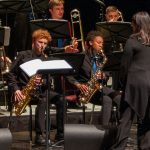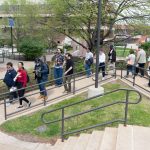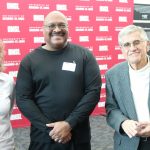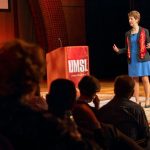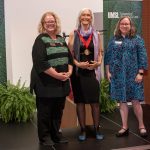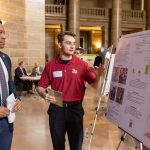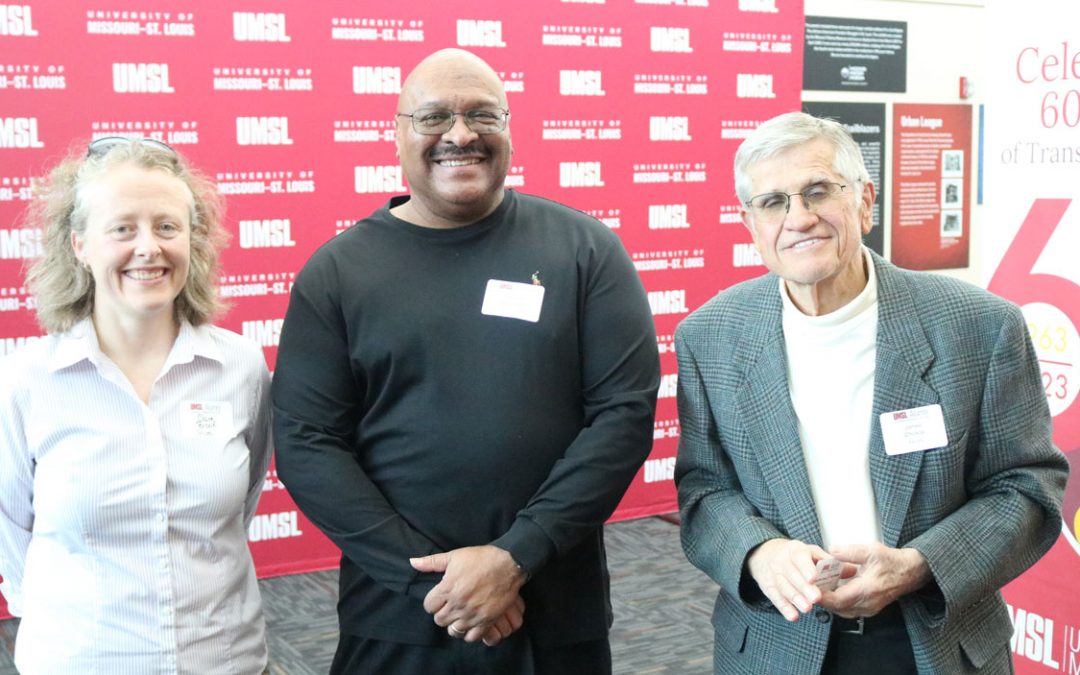
UMSL doctoral candidates William Ellegood (left) and Jeremy North have developed a system for more efficiently transporting students from bus stops to school doors. Their project, "Applying Business Logistic Optimization Modeling to School Bus Routing,” won first place at the Graduate School Research Fair. (Photo by Jack Crosby)
Transportation continues to be a growing cost for area school districts facing annual budget cuts.
University of Missouri–St. Louis doctoral candidates Jeremy North and William Ellegood may have just discovered a way to save thousands of dollars on busing and routing for districts. The pair recently won first place at the Graduate School Research Fair for their project “Applying Business Logistic Optimization Modeling to School Bus Routing.”
North and Ellegood, both students pursuing doctoral degrees in logistics and supply chain management at UMSL, worked under the direction of James Campbell, professor of logistics and supply chain management, and with funding from the University of Missouri System, to develop a system for more efficiently transporting students from bus stops to school doors.
“Our research applies best practices and optimization modeling techniques from business logistics to improve school bus routing in rural districts,” Ellegood said. “A lot of school districts still route by ‘pins and strings’ meaning manually. I contacted a school district near me and asked, and sure enough they were routing manually.”
From there, he started looking into mixed loading options where one bus would transport students from one area to various schools as opposed to several buses picking up from one neighborhood and dropping off at numerous schools.
“We investigated the use of mixed loads of students and the consolidation of bus stops to reduce bus travel,” Ellegood said. “Mixed loads and consolidation are two powerful supply chain strategies that have proven beneficial in freight logistics. In the state of Missouri, school buses travel 124 million miles annually transporting students, and they transport roughly 560,000 students daily to and from school. That’s why it’s important. And with the state cutting the funding they provided public school districts for transportation, districts need an improvement from a routing stand point to reduce cost.”
The Windsor C-1 School District in Imperial, Mo., is the current test case for the mix loading formula. The district has both highly populated subdivisions and rural areas.
The algorithm that North developed to solve the problem is a two phase solution approach featuring a construction heuristic followed by an integer programming model. With the goal of minimizing total transportation distance and the number of buses required, the entire solution approach was coded and implemented in the Python and C programming languages.
“The preliminary results of this work outperform the other mixed loading implementations of the SBRP found in the literature on benchmark datasets,” he said.
Ellegood and North plan to continue to work in this field in the future. They both hope to complete their PhD programs in the spring of 2013.
Ellegood earned a master’s degree in business administration from Ball State University in Muncie, Ind., and a bachelor’s degree in mechanical engineering from GMI–Engineering and Management Institute Flint, Mich. He has more than 12 years experience in the manufacturing business.
North earned a bachelor’s and master’s degrees in business administration from Pittsburg (Kan.) State University in Pittsburg. He served for five years as a counter intelligence agent in the United States Army, deploying twice and earning the rank of sergeant.


